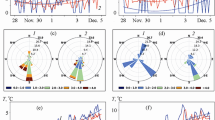Summary
Graz, a historical grown city in the south-east of Austria, sometimes faces problems with air pollution, mainly during wintertime. The old part of the city is the largest residentially used historical downtown in Central Europe. Due to its geographical position at the southeastern edge of the Alps, Graz often has weather situations with calm winds and strong inversions between October and March. The local wind system is marked by wind shears: near the surface, cold air flows in from the south, while in higher altitudes warm air from the north flows over the basin of Graz. During these winterperiods with mighty inversions air quality values exceed the threshold limits. The reason is that the old structure of the downtown area with narrow streets and a lot of old domestic heating systems in many of the old buildings causes relatively high pollution levels. In the winter of 1988/89, the NO2 threshold values for smog-alarm (0.8 mg/m3, 3-h mean value) were exceeded several times at three air quality monitoring stations in the city of Graz. Therefore, a research project was initiated with the aim to find out the reasons for the bad air quality. The project comprised the setting up of an emission inventory as well as meteorological measurement campaigns and numerical simulations concerning the pollution dispersion in the area of Graz. The following report will try to show the interaction of the emission inventory on one hand and the determinations of flow conditions and pollutant dispersion on the other hand in order to analyze the air quality in the city. The emission inventory contains the emissions of air pollutants in a high temporal and spatial resolution. Before determining the surface flow fields, the meteorological conditions leading to the high pollution values were analyzed. After that, the boundary conditions were defined with the help of tethered balloon measurements. With these boundary conditions, quasi-steady-state flow fields were simulated. The dispersion of pollutants was calculated in a transient form using the stored flow fields. Conversion of pollutants was determined with the help of a parameterized version of the Eschenroeder-Martinez reaction mechanism. The period of winter 1990/91 with the highest pollution concentration was simulated to validate this model. The results show that the simulated and measured values of CO, NO and NO2 correspond well with each other in the centre of the city, while the correspondence is not as good in the outskirts of the city were lower pollution levels are observed. It turned out that the suggested methodology is well suited for analyzing winter situations with high pollution levels.
Similar content being viewed by others
References
Almbauer, R., 1991: Berechnung der Luftströmungen über einem Stadtgebiet unter Berücksichtigung der Meteorologie am Beispiel Graz. Dissertation am Institut für Verbrennungskraftmaschinen und Thermodynamik, TU-Graz.
Dunker, A. M., 1986: The reduction and parameterization of chemical mechanisms for inclusion in atmospheric reaction-transport models.Atmos. Environ.,20, 173–188.
Eschenroeder, A. Q., Martinez, J. R., 1972: Concepts and applications of photochemical smog models.Adv. Chem.,133, 101–167.
Groß, G., 1988: Numerical simulation of the nocturnal flow system in the Freiburg area for different topographies.Beitr. Phys. Atmos.,1(89), 1988.
Hassel, D. et al., 1987:Das Abgasemissionsverhalten von KFZ in der BRD im Bezugsjahr 1985. Bericht 7/87 E. Schmidt, Berlin.
Heimann, D., Rösler, F., Baltrusch, M., 1988:Numerical Case Studies of Air Pollution in and around Agglomeration Areas During Inversion Situations. Environmental Meteorology, pp. 531–544. Dordrecht, Kluwer.
Lazar, R., 1990: 1. und 2. Zwischenbericht über die meteorologisch-klimatologischen Untersuchungen als Grundlagen für ein Immissions-Prognosemodell im Raum Graz, Internal report.
Moussiopoulos, N., 1989: Mathematische Modellierung mesoskaliger Ausbreitung in der Atmosphäre, VDI Fortschritt-Berichte Reihe 15 Nr. 64. Düsseldorf: VDI-Verlag.
Moussiopoulos, N., Kaiser, G., 1993: Thessaloniki Field Measurement Campaign. Scientific Series of the International Bureau/Forschungszentrum Jülich GmbH, Vol.18.
Nester, K., Fiedler, F., 1992:Comparison of Measured and Simulated SO 2,NO, NO 2 and Ozone Concentrations for an Episode of the TULLA Experiment. Air Pollution Modeling and Its Application IX pp. 259–266. New York: Plenum Press.
Patankar, S. V., 1980:Numerical Heat Transfer and Fluid Flow, Washington: Hemisphere Publishing Corporation, McGraw Hill.
Pischinger, R. et al., 1990: Emissionskataster der Stadt Graz, Bezugsjahr 1988, Herausgeber: Amt der Steierm. Landesregierung, Landesbaudirektion, Fachabteilung Ia.
Sampl, P., 1991: Simulation von Schadstoffausbreitung und Luftchemie im Grazer Becken, Dissertation am, Institut für Verbrennungskraftmaschinen und Thermodynamik, TU-Graz, 1991.
Somieski, F., 1987: Numerische Simulation der thermisch angeregten Zirkulation zwischen Gebirge und Vorland. Forschungsbericht des Institutes für Physik der Atmosphäre, Oberpfaffenhofen, DFVLR-FB 87-30.
Sturm, P. J., 1988: Berechnung der räumlichen Schadstoffausbreitung in der Nähe von Gebäuden im Einflußbereich von Straßen und Tunnelportalen. Dissertation am Institut für Verbrennungskraftmaschinen und Thermodynamik, TU-Graz.
Turner, D. B., 1985: Proposed pragmatic methods for estimating plume rise and plume penetration through atmospheric layers.Atmos. Environ.,19, 1215–1218.
Author information
Authors and Affiliations
Additional information
With 10 Figures
Rights and permissions
About this article
Cite this article
Almbauer, R., Pucher, K. & Sturm, P.J. Air quality modeling for the city of Graz. Meteorl. Atmos. Phys. 57, 31–42 (1995). https://doi.org/10.1007/BF01044152
Received:
Revised:
Issue Date:
DOI: https://doi.org/10.1007/BF01044152




